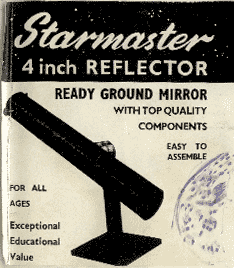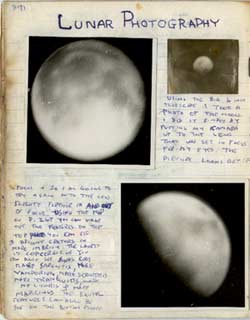 SO
WHAT IS IT that Brian May and I have in common? No, I've
never played guitar from the roof of Buckingham Palace; it goes back further
than that; as a boy, May's interest
in astronomy led him to buy a telescope kit which, from his description,
was exactly like mine, a 4 inch reflector. I bought 'the Starmaster',
from Charles Frank of Glasgow in the 1960s, price £7 including postage.
Assembling the tube, the wing-nut
&
wood altazimuth
mount
and the stand was simple enough but I had to go to a family
friend, Mr Walker, for the
fiddly job of setting the secondary mirror on a piece of dowel.
SO
WHAT IS IT that Brian May and I have in common? No, I've
never played guitar from the roof of Buckingham Palace; it goes back further
than that; as a boy, May's interest
in astronomy led him to buy a telescope kit which, from his description,
was exactly like mine, a 4 inch reflector. I bought 'the Starmaster',
from Charles Frank of Glasgow in the 1960s, price £7 including postage.
Assembling the tube, the wing-nut
&
wood altazimuth
mount
and the stand was simple enough but I had to go to a family
friend, Mr Walker, for the
fiddly job of setting the secondary mirror on a piece of dowel.
 I've
taken it down from the attic for the first time in years to take a look at Comet
Holmes which I heard about last week from Rheba,
our friend in Texas, who has been admiring its unexpected outburst of brilliance.
The comet is well up in sky, so looking at it through my bird-watching refractor
telescope would involve leaning over backwards. With a reflecting telescope
like the Starmaster you look in through the side of the tube.
I've
taken it down from the attic for the first time in years to take a look at Comet
Holmes which I heard about last week from Rheba,
our friend in Texas, who has been admiring its unexpected outburst of brilliance.
The comet is well up in sky, so looking at it through my bird-watching refractor
telescope would involve leaning over backwards. With a reflecting telescope
like the Starmaster you look in through the side of the tube.
No other comet has been observed behaving as Holmes has. It appears to have
exploded, creating a ball of dust and gas the size of the sun. Edwin
Holmes discovered this comet when it flared up in a similar way in
November 1892, which was one year after the first Sherlock
Holmes short
story appeared in the Strand magazine. In A Study in Scarlet (a full-length
novel published in 1887) Dr Watson is astonished to learn that Holmes is unaware
of the Copernican theory of
astronomy:
"What the deuce is it to me?" he interrupted impatiently; "you
say that we go round the sun. If we went round the moon it would not make a
pennyworth of difference to me or to my work."
I've had a Sherlock Holmes book
in preparation for some time.
'I am positive that Comet Holmes is in the sky to push you to finish your
book', says Rheba. I had better get on with it!
 The
comet is so large that it almost fills the field of view of my reflecting telescope.
It's easily seen with binoculars too and, if the sky was as clear
as the skies Rheba enjoys in Central Texas, it would show up well with the
naked eye. Once I'd discovered where it was with binoculars, I could find it
by eye,
but,
like
other
faint objects,
it
was easier to see when you didn't look directly at it.
The
comet is so large that it almost fills the field of view of my reflecting telescope.
It's easily seen with binoculars too and, if the sky was as clear
as the skies Rheba enjoys in Central Texas, it would show up well with the
naked eye. Once I'd discovered where it was with binoculars, I could find it
by eye,
but,
like
other
faint objects,
it
was easier to see when you didn't look directly at it.
 Through
binoculars, the
Andromeda Galaxy (right) is a small, pale misty streak
compared
with luminous
sphere of the comet.
Through
binoculars, the
Andromeda Galaxy (right) is a small, pale misty streak
compared
with luminous
sphere of the comet.
I remember the first time I used the Starmaster; I turned it at random to
a patch of the night sky and it revealed dozens of tiny points of light that
you wouldn't have guessed were there. Comet Holmes is
large
enough
to be seen more easily with binoculars, but I'm glad to have seen it through
my old telescope.
I turn the telescope towards the Plieades;
a cluster of stars that looks more spectacular through the telescope.
The familiar shape, which reminds me of the Plough (Great
Bear) in miniature, is shown upside down in the reflector and the 'Seven
Sisters' of the constellation
are joined by dozens more companions.
A page from my 1964 notebook shows my attempts at lunar photography using
the telescope
 SO
WHAT IS IT that Brian May and I have in common? No, I've
never played guitar from the roof of Buckingham Palace; it goes back further
than that; as a boy, May's interest
in astronomy led him to buy a telescope kit which, from his description,
was exactly like mine, a 4 inch reflector. I bought 'the Starmaster',
from Charles Frank of Glasgow in the 1960s, price £7 including postage.
Assembling the tube, the wing-nut
&
wood altazimuth
mount
and the stand was simple enough but I had to go to a family
friend, Mr Walker, for the
fiddly job of setting the secondary mirror on a piece of dowel.
SO
WHAT IS IT that Brian May and I have in common? No, I've
never played guitar from the roof of Buckingham Palace; it goes back further
than that; as a boy, May's interest
in astronomy led him to buy a telescope kit which, from his description,
was exactly like mine, a 4 inch reflector. I bought 'the Starmaster',
from Charles Frank of Glasgow in the 1960s, price £7 including postage.
Assembling the tube, the wing-nut
&
wood altazimuth
mount
and the stand was simple enough but I had to go to a family
friend, Mr Walker, for the
fiddly job of setting the secondary mirror on a piece of dowel. I've
taken it down from the attic for the first time in years to take a look at Comet
Holmes which I heard about last week from Rheba,
our friend in Texas, who has been admiring its unexpected outburst of brilliance.
The comet is well up in sky, so looking at it through my bird-watching refractor
telescope would involve leaning over backwards. With a reflecting telescope
like the Starmaster you look in through the side of the tube.
I've
taken it down from the attic for the first time in years to take a look at Comet
Holmes which I heard about last week from Rheba,
our friend in Texas, who has been admiring its unexpected outburst of brilliance.
The comet is well up in sky, so looking at it through my bird-watching refractor
telescope would involve leaning over backwards. With a reflecting telescope
like the Starmaster you look in through the side of the tube. The
comet is so large that it almost fills the field of view of my reflecting telescope.
It's easily seen with binoculars too and, if the sky was as clear
as the skies Rheba enjoys in Central Texas, it would show up well with the
naked eye. Once I'd discovered where it was with binoculars, I could find it
by eye,
but,
like
other
faint objects,
it
was easier to see when you didn't look directly at it.
The
comet is so large that it almost fills the field of view of my reflecting telescope.
It's easily seen with binoculars too and, if the sky was as clear
as the skies Rheba enjoys in Central Texas, it would show up well with the
naked eye. Once I'd discovered where it was with binoculars, I could find it
by eye,
but,
like
other
faint objects,
it
was easier to see when you didn't look directly at it. Through
binoculars, the
Andromeda Galaxy (right) is a small, pale misty streak
compared
with luminous
sphere of the comet.
Through
binoculars, the
Andromeda Galaxy (right) is a small, pale misty streak
compared
with luminous
sphere of the comet.